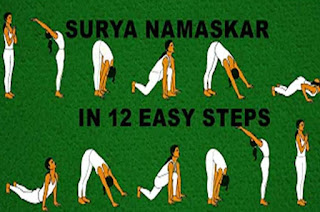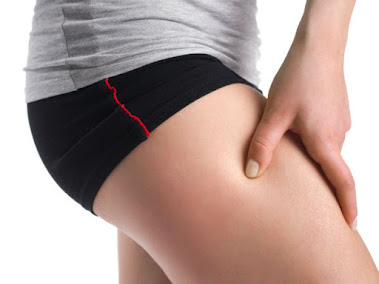SuryaNamaskar: Various Asanas, Importance and Methods !!
Surya
Namaskar is considered to be the best of the Yogasanas, it is also called as
Sarvanga Vyayama. Only its regular practice is capable of giving the benefit of
complete yoga exercise to the person. By its practice, the person's body
becomes healthy and glowing. 'Surya Namaskar' is said to be useful for women,
men, children, young and old people.
When to
do Surya Namaskar?
Like all
yogic activities, sunrise in the morning is considered the best time for Surya
Namaskar. Suryanamaskar should always be practiced on an empty stomach by
laying a blanket seat in an open airy place. Only if the mind is calm and
happy, the full effect of yoga is obtained.
Why
should we practice the Suryanamaskar ?
With the
increase of physical and mental energy by regular practice of Surya-Namaskar,
thinking power and memory power are also intensified. It has many other benefits
which are as follows:
· Increases blood circulation to all
the vital organs.
· Vitamin-D is obtained from Surya
Namaskar, which strengthens bones.
· Eyesight increases.
· The flow of blood in the body is
accelerated, which provides relief in the disease of blood pressure.
· The effect of Surya Namaskar falls on
the mind and the mind remains cool.
· By reducing the fat near the abdomen,
the amount (weight) is reduced, due to which it is very helpful in reducing the
weight of obese people.
· Prevents hair loss and dandruff.
· Helps in controlling anger.
· The waist is flexible and the spine
is strong.
· The chances of getting skin diseases
are eliminated.
· Increases the efficiency of heart and
lungs.
· The nerves in the arms and waist
become strong.
· Digestion improves.
· The concentration of the mind
increases.
· It activates all the organs, muscles
and nerves of the body.
· By its practice, there is a
surprising increase in the elasticity of the body. Adults and old people also
practice it regularly, then the elasticity of their body becomes like that of
children.
· Helps in balancing the secretion of
all the important glands of the body like pituitary, thyroid, parathyroid,
adrenal, liver, pancreas, ovary etc.
· Activates and strengthens all the
institutions of the body, blood circulation, breathing, digestion, excretion,
nerves and glands.
· It plays a very useful role in the
solution of problems related to digestion, indigestion, constipation,
indigestion, gas, flatulence and loss of appetite.
· Helps to balance Vata, Pitta and
Kapha. Helps in alleviation of tridosha.
· By its practice the blood circulation
is accelerated and the speed of metabolism increases, due to which all the
parts of the body become strong and functional.
With its
regular practice, obesity can be removed and it can also be kept away from it.
What are
the Suryanamaskar steps?
Surya
Namaskar is practiced in twelve positions, which are as follows-
(1) Salutation
Stand
straight with both hands folded. close your eyes By concentrating on the 'Agya
Chakra', invoke the 'Sun' through the mantra 'Om Mitraya Namah'.
(2) Hasta
Uttanasana
While
inhaling, stretch both the hands up close to the ears and bend the arms and
neck backwards. Concentrate on the 'Vishuddhi Chakra' at the back of the neck.
Also know
the Surya namaskar mantra.
(3) Uttanasana
In the third
position, while exhaling slowly, bend forward. Hands with the neck, going down
adjacent to the ears, touch the earth on the right and left of the feet. Keep
knees straight. Stay in this position for a few moments while concentrating on
the 'Manipuraka Chakra' behind the navel while the forehead touches the knees.
Do not do sadhaks with back and spine defects.
(4) Ashwa
sanchalanasana
In this
position, while inhaling, move the left leg backwards. Pull the chest forward
and stretch it. Tilt the neck more backward. Leg stretched straight back and
toe raised. Stay in this position for some time. Move the meditation to
'Swadhisthana' or 'Vishuddhi Chakra'. Keep your face normal.
(5) Chaturanga
Dandasana
While
exhaling the breath slowly, take the right leg back as well. The heels of both
the feet should meet each other. Stretch the body backwards and try to match
the ankles to the earth. Raise the buttocks up as much as possible. Tilt the
neck down and place the chin in the groin. Practice focusing on the 'Sahasrara
Chakra'.
(6)
Ashtanga Namaskar
While
inhaling, make the body parallel to the earth, prostrate straight and first put
the knees, chest and forehead on the earth. Raise the buttocks slightly.
Breathe out. Focus your attention on the 'Anahata Chakra'. Normalize breathing
rate.
(7)
Bhujangasana
In this
position, while slowly filling the breath, straighten the hands while pulling
the chest forward. Move the neck backward. Keep the knees touching the earth
and the toes of the feet standing. Pulling the mooladhara and fix the
meditation there.
(8) Adhomukt
Swanasana/Parvatasana
While
exhaling the breath slowly, take the right leg back as well. The heels of both
the feet should meet each other. Stretch the body backwards and try to match
the ankles to the earth. Raise the buttocks up as much as possible. Tilt the
neck down and place the chin in the groin. Practice focusing on the 'Sahasrara
Chakra'.
(9) Ashwa
sanchalanasana
In this
position, while inhaling, move the left leg backwards. Pull the chest forward
and stretch it. Tilt the neck more backward. Leg stretched straight back and
toe raised. Stay in this position for some time. Move the meditation to
'Swadhisthana' or 'Vishuddhi Chakra'. Keep your face normal.
(10) Uttanasana
In the third
position, while exhaling slowly, bend forward. Hands with the neck, going down
adjacent to the ears, touch the earth on the right and left of the feet. Keep
knees straight. Stay in this position for a few moments while concentrating on
the 'Manipuraka Chakra' behind the navel while the forehead touches the knees.
Do not do sadhaks with back and spine defects.
(11) Hasta
Uttanasana
While
inhaling, stretch both the hands up close to the ears and bend the arms and
neck backwards. Concentrate on the 'Vishuddhi Chakra' at the back of the neck.
(12) Salutation
This
position will remain like the first situation.




Comments
Post a Comment